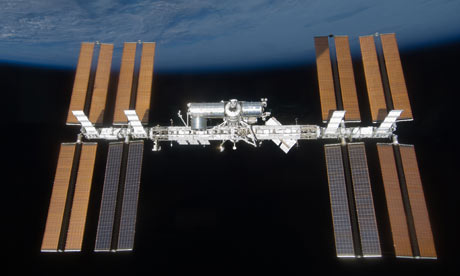
The International Space Station as seen from the US space shuttle Discovery. Photograph: Nasa/AFP/Getty Images
A big piece of space junk is drifting toward the shuttle-station complex and its 13 astronauts, though Nasa said it would not delay a spacewalk.
Mission control is keeping close tabs on the piece of European rocket in case it comes too close to the linked space shuttle Discovery and international space station.
The debris is expected to pass within two miles of the space station tomorrow John McCullough, chief of Nasa's flight director office, said last night.
That is five miles closer than earlier projections, but McCullough said it was "looking very positive" that the shuttle and station would not have to change direction to dodge the junk.
The debris' oval-shaped orbit, which stretches as far out as 20,000 miles, has made it especially difficult to monitor.
Experts estimate that the piece of junk – part of a booster on a three-year-old Ariane 5 rocket used to deploy a satellite – has about 18.5 square metres of surface area.
The news did not affect the work of the two crews aboard the complex. They got ready for a spacewalk, moved more cargo into the space station and installed some new items, including a sleeping compartment.
Shuttle astronaut José Hernández, a Mexican-American who grew up in a migrant worker family, also took time out for several TV interviews.
The astronaut sent greetings to the Mexican president, Felipe Calderón, as well as his Aunt Rosa, who promised to have some good meat tacos waiting for him.
Hernández said he bicycled and ran every day, even in space. "That way, I can eat all the Mexican tacos and cornitas and mole," he said.
If mission control decides the shuttle-station complex needs to dodge the orbiting debris, the move into a higher orbit will not happen until after tonight's spacewalk.
The astronauts performed the first of three planned spacewalks on Tuesday, removing an old ammonia tank from the space station. Tonight two spacewalkers will install a new tank to replenish the cooling system of the outpost.
Discovery will remain at the space station until Tuesday.
Source
